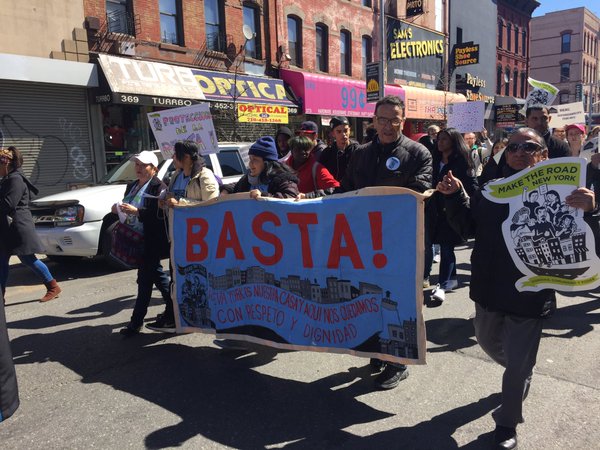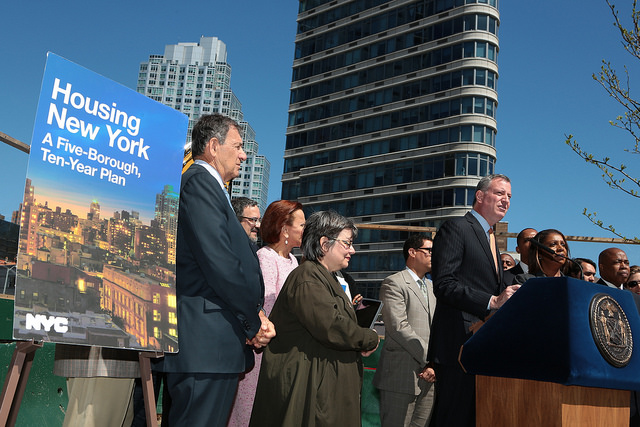Eviction Bonuses and Preferential Rents, Not 421-a, Should Be the Focus in Albany

An affordable housing march
We have long advocated for the elimination of the 421-a tax abatement because it has been nothing but a giveaway to developers masquerading as a means of affordable housing production. This is why affordable housing advocates across the city celebrated when 421-a expired on January 15.
Since its expiration, arguments about its possible revival are popping up more and more frequently, along with lamentations about its demise. How quickly we forget the many published analyses exposing the fact that even though the controversial tax abatement has created little affordable housing, it has cost New York City taxpayers up to $1 billion in lost tax revenue annually.
Only about 1,350 affordable apartments were created over the previous four years of this wasteful program. That is fewer than 350 per year, and with a price tag of $833,000 per affordable apartment created.
Instead of discussing benefits for rich developers, all attention should be on fixing the major loopholes in the rent regulation system that houses 2.5 million tenants in approximately 1 million units with no cost whatsoever to the taxpayer.
One of the most egregious of these loopholes is the "eviction bonus," which allows enormous rent increases of up to 20 percent in rent-stabilized apartments upon vacancy. This may be the greatest threat to the affordability and retention of rent-regulated housing, which is the foundation of strong and diverse communities and the reason that tenants looking to move are faced with unaffordable rents in every neighborhood in this city. The eviction bonus affects tens of thousands of low- and middle-income tenants – far more than those benefiting from 421-a.
Then there are "preferential" rents, the other much-used landlord tool for driving rents and pushing tenants out of rent-regulated apartments. An estimated 325,000 low-income families are vulnerable to unaffordable rent increases upon lease renewal because the preferential rent system affects 1,000 times as many families than those that benefit from new 421-a affordable units each year.
These were the reasons for a major rally of 300 community folks this week in the quickly gentrifying neighborhood of Bushwick, where Brooklyn residents described the many tactics used by landlords to evict rent-stabilized tenants in order to increase rents.
The rent laws were renewed in June 2015, with nowhere near the reforms necessary to protect tenants in New York. Without strong rent regulations, tens of thousands of tenants will eventually be met with only two choices: end up in homeless shelters or leave the city altogether. Neither is acceptable.
As the state moves beyond budget negotiations into legislative session, rent laws should become the focus of discussion, not the $1 billion 421-a developer giveaway. The millions of low-income tenants at risk of losing their homes and stable communities are more than enough reasons.
[Related: De Blasio Calls for Albany to 'Make Right' on Program at Center of Rift with Governor]
***
Delsenia Glover is the campaign manager for the Alliance for Tenant Power. On Twitter @TenantPowerNY.
***
Have an op-ed idea or submission for Gotham Gazette? Email This email address is being protected from spambots. You need JavaScript enabled to view it.
Key Piece of City's New Housing Deal Will Protect Tenants from Harassment

Housing plans (photo: Ed Reed for the Office of Mayor)
Last week, New Yorkers learned that a bill creating a new Citywide Certificate of No Harassment program would be part of the city's new housing deal. The legislation, which will be finalized by a new task force before being adopted, will require landlords to get a certificate confirming that they have not harassed their tenants before demolishing or altering a building.
This provision of the housing deal is especially good news for tenants across the city.
As real estate prices have skyrocketed and gentrification has spread, so too has rampant harassment by landlords. All too often, they try to get rid of working-class and low-income tenants, especially those in rent-regulated apartments, so they can renovate units and lease them at much higher prices. This pattern has displaced thousands of tenants and left all too many with nowhere to go.
Take the case of María Elena Khochaiche, a retired, low-income renter who lived in her rent-regulated Bushwick apartment for 40 years. Recently, the value of her apartment rose quickly with the neighborhood's gentrification. Her landlord responded with greed: he tried to get rid of the rent-regulated tenants, including her, because he knew that he could make more with market-rate tenants.
He began by taking them each to court. They had done nothing wrong, but the fear of frivolous lawsuits led several residents to simply give up and leave.
Eventually, all the other tenants left, but María Elena had nowhere to go. She knew she'd never be able to afford another apartment in Bushwick. But that didn't stop the landlord. Instead of letting María Elena stay in peace, the landlord opted to stop making legally-required repairs to pressure her to leave. Broken windows stayed so she could not open them, the bathtub stayed backed up so she could not bathe, and a mouse infestation went unaddressed. For months, the lights in the hallways did not work. Seventy-five-year-old María Elena had to use the light from her cell phone just to make sure that she didn't fall while she struggled to reach her front door.
María Elena followed the rules and filed a housing complaint, but her landlord took advantage of the process and filed numerous motions to bog down the case.
Eventually, María Elena couldn't take it anymore. When the landlord offered her a buy-out to leave, she just couldn't fight on, even though she knew that taking it would mean not being able to stay in the community she loved.
The decision troubled her, but María Elena was one of the "lucky" ones. Her neighbors were forced out without getting as much in return.
María Elena's experiences are all too common for New York City tenants. Landlords harass tenants to try to get them out of affordable housing—often by using threats or legal action, or failing to make repairs that they need to make apartments livable—and then, once the tenants are gone, either renovate or build new market-rate units to rake in as much profit as possible.
The result: many New Yorkers end up with nowhere to go.
Without requiring landlords to obtain a Certificate of No Harassment, unscrupulous landlords will continue to use every trick in the book to cut corners and push tenants like María Elena out. But when landlords are required to get a Certificate of No Harassment before starting renovations or demolition, they will not be able to get away profiting from mistreating their tenants. And if they do, their mistreatment would come to light and subsequent construction or demolition would be blocked unless the landlord provided a "cure" of permanently affordable units.
This "cure" of setting aside permanently affordable units will be critical for making sure no landlord can profit from harassment. And taking away the profit motive will provide a strong disincentive for harassing tenants in the first place.
The Certificate of No Harassment legislation, once finalized and voted into law, will bring greater peace of mind to tenants like María Elena and be a substantial victory in the fight to hold abusive landlords accountable for harassing their tenants.
***
Javier H. Valdés is the Co-Executive Director of Make the Road New York. Benjamin Dulchin is the Executive Director of the Association for Neighborhood Housing and Development. On Twitter: @MaketheRoadNY & @ANHDNYC.
New Yorkers Run for President: History and Insights for 2016

Donald Trump at a rally (photo: Trump campaign website)
continued from page 2 - this is page 3 of 3
Even more New Yorkers
If you count vice presidential nominees too, New Yorkers were on major ballots in 15 out of the 29 races from 1900 to 2012.
The New Yorker vice presidential nominees during the period since 1900 were Theodore Roosevelt, R, 1900; James Sherman, R, 1908; Franklin D. Roosevelt, D, 1920; William Miller, R, 1964; Geraldine Ferraro, D, 1984; and Jack Kemp, R, 1996. TR was elected with William McKinley. Sherman was elected with Taft (but died in office in 1912). The others went down to defeat along with the presidential nominees at the head of their tickets.
Of course, the list of New Yorkers in presidential politics gets even longer if you count prominent New Yorkers who were major contenders but failed to get the nomination. That would include Governors Nelson Rockefeller (R), who lost the nomination to Barry Goldwater in 1964 and Mario Cuomo (D) who agonized over whether to run in 1988 and 1992 and decided not to take the plunge.
The list would include Senator Robert Kennedy (D), who was assassinated during his quest for the 1968 Democratic presidential nomination. Rep. Shirley Chisolm, the first black woman elected to Congress (in 1968) campaigned for the Democratic presidential nomination in 1972. New York City Mayor John Lindsay switched from the Republican to the Democratic Party in 1971 and launched a brief but unsuccessful bid for the 1972 Democratic presidential nomination. Rudolph Giuliani (R), mayor from 1994 to 2001, sought his party's 2008 nomination, losing to John McCain.
Possible insights for 2016
It is always exciting when New Yorkers run for president! But finding parallels or applicable lessons from that history is a challenge. A few tentative insights:
*The New Yorkers who made it to the presidency in the 20th century -- Theodore Roosevelt and Franklin Roosevelt-- were among the nation's strongest presidents, constantly rated by historians in the top tier of our national leaders.
*Defeating a sitting President is difficult, as challengers learned in 1904, 1912, 1936, 1940, 1944, and 1948. On the other hand, running on the legacy of a previous president can help, as it did for Taft in 1908, Hoover in 1928, and Truman in 1948. That pattern may help Hillary Clinton, who can claim to be heir to at least some of Barack Obama's policies.
*Americans seem to prefer an exuberant campaign style over what might be called a judicious, restrained style. That subdued demeanor is sometimes associated with judges who are inclined to weigh and balance and look for nuances, e.g., possibly Parker in 1904, Hughes in 1916, and Taft (a judge before becoming TR's Secretary of War.)
*Red herrings and false issues can derail even a strong, thoughtful candidate, as Al Smith learned in 1928 when he was attacked for his religious beliefs.
*Wendell Willkie, a businessman who had never held political office, made a credible candidate in 1940. But his tenor and message were much different from businessman Donald Trump's today. He was a moderate, compromiser, inclined toward inclusion and accommodation, a unifier who tried to swing his party toward the mainstream.
*There may be a rough parallel between the "Stop Roosevelt!" campaign in the Republican party in 1911 and 1912 and the "Stop Trump!" campaign that some Republican leaders are mounting today. TR had triumphed in most of the primaries in 1912, though only a minority of states had them at that time, and could claim with some justification that where people had the chance to vote, they favored him as the Republican candidate. Trump is racking up primary wins this year. But TR expressed concrete, progressive, well-considered proposals and never resorted to bombast or bullying, which seem to be part of Trump's style.
*Hailing from New York can be a mixed blessing, as evidenced by Senator Ted Cruz' snide comment about Donald Trump representing "New York values." That sort of comment, with the vague innuendo it conveys, is something that Al Smith might have understood.
***
The New York presidential primaries are Tuesday, April 19; the general election will take place on Tuesday, November 8, 2016.
This is page 3 of 3. Revisit page 1 or page 2 of this article.
***
Dr. Bruce W. Dearstyne's latest book is The Spirit of New York: Defining Events in the Empire State's History, published in 2015 by SUNY Press.
***
Have an op-ed idea or submission for Gotham Gazette? Email This email address is being protected from spambots. You need JavaScript enabled to view it.




